Kanban: Definition, 6 Rules, and its Benefits
Kanban is a crucial part of the Just in Time (JIT) system, which we discussed…
Sean Thobias
May 17, 2025In the previous chapter, we tackled hiring, training, and making tough decisions with your team. Now that your retail store is running, it’s time to focus on crucial management practices.
To ensure your store’s success, master 13 retail best practices that cover customer expectations, financial tracking, and operational efficiency. Go beyond the usual strategies and adopt innovative approaches to elevate your retail management game.
Running a successful retail store involves many tasks, often making it easy to lose sight of your initial motivation. Doubts about the wisdom of your decision may creep in, but it’s crucial to stay focused on the big picture.
As a budding business owner, embracing the role of the boss might feel like uncharted territory, especially if you’re managing a small store solo.
The success of your store rests squarely on your shoulders, so it’s crucial to set clear goals and a vision. Think of yourself as a locomotive engineer responsible for keeping things moving smoothly and on the right track.
Your initial business plan outlines your retail venture’s aspirations, solidifying your store’s vision and purpose. Yet, it’s easy to lose sight of those goals in day-to-day operations.
Define clear and specific goals for your retail store. Whether increasing retail sales, expanding customer loyalty, or optimizing inventory turnover, having well-defined objectives provides a roadmap for success and helps measure progress effectively.
Create detailed plans covering short-term and long-term strategies for your retail business. It’s important to include plans for inventory management, marketing efforts, and customer engagement to align decisions with overall business goals.
Be specific in your plans, as they are actions that will guide your daily and weekly tasks and those of your staff. As a manager, you break down broad business goals into actionable plans that drive day-to-day operations.
Keep your eyes on the prize by consistently checking how your plans are going. Staying focused stops distractions and ensures your whole team is working towards the big goals for your store.
People tackle details in various ways, from overlooking them to creating extensive to-do lists. Planning tools are beneficial to help managers juggle tasks and stay on track. Experiment with different methods to find what works best.
Running a retail business might seem like a lot, but it becomes simpler when you break it down into principal and side tasks, each with a specific goal. Once you have mastered these tasks, you will be better equipped to handle any daily issues.
Running a retail store involves various straightforward and more intricate processes. Focus on documenting the critical processes essential for your operation and any that cause issues for you and your team.
Create an operations manual for your store, breaking it into two parts: one for management and one for employees, each outlining their primary responsibilities. Keep everyone in the loop about changes in the employee manual to ensure all team members are on the same page.
Not every process is effective; sometimes, people don’t stick to the plan. If a process you’ve set up isn’t giving the desired results, look at how it’s affecting your store.
Regularly check how your operational decisions are affecting your store’s performance. If a process is causing problems for your employees, offer training to clarify and improve understanding for everyone, ensuring a smoother workflow.
A study by Gallup Workplace found that companies focusing on customers experienced a 25% boost in loyalty and a 20% increase in customer confidence.
Therefore, keeping customers happy is the key to success. Put them first to build trust and loyalty and ensure your business grows steadily.
Align your store hours with your customers’ shopping habits by conducting market research to identify their preferred times. Make any adjustments gradually to avoid disrupting their routines.
If your store sees peak profits during the first or last hours, consider opening earlier or extending your closing time by 30 minutes to an hour. Monitor retail sales and profitability for at least a month before officially changing your business hours.
When selling, focus on consultative selling — building trust and understanding your customer’s needs before suggesting a solution. Most shoppers like this approach because it adds value to customer experience.
Focus on these three consultative selling guidelines:
Your key customers don’t necessarily visit often or make the most purchases; they bring in the most profits. Once you have pinpointed your core customers, reach similar ones through targeted advertising.
Encourage your top customers to spread the word, and consider loyalty programs to keep them returning. To streamline all this, consider using customer relationship management (CRM) software to maintain customer satisfaction effectively.
Keep a close eye on your retail business finances. It helps you know your finances, make intelligent choices, and follow tax rules to avoid extra payments and penalties.
Regularly match your bank statements with your accounting records. It helps keep things accurate and catches any mistakes early, saving you from future financial hassles.
Invest in easy-to-use accounting software to simplify tracking and sorting transactions, creating reports, and clearly showing how your retail business is doing financially.
Make it a habit to record each business transaction right away. Whether it’s a sale, an expense, or any other money-related activity, it’s essential to record it.
Consider getting Point of Sale (POS) system to make tracking retail sales smoother. These systems automate the sales process and keep a digital record, saving time and reducing errors in your financial records.
Keep yourself informed about tax rules that matter to your retail business. Knowing the latest regulations helps you grab available deductions, avoid penalties, and stay in line with tax laws.
This simple habit also helps you avoid surprises like fines and keeps your retail venture running smoothly in the eyes of the tax authorities.
Identify and monitor key financial metrics specific to your retail business, such as gross profit margin, inventory turnover, and average transaction value. Tracking these KPIs provides insights into your business’s overall financial performance.
If specific strategies aren’t working, pivot. If you surpass expectations, determine what’s driving that success and consider doing more.
When running your retail store, concentrate on smart retail management practices. Prioritize customer needs, keep a keen eye on your finances, and implement efficient operational procedures for lasting success.
Incorporate software solutions like POS systems, accounting, and CRM tools to improve efficiency, reduce errors, and gain valuable insights. The next chapter will explore essential metrics for your retail business.
Read more: Retail Software: a Selection Guide and its 5 Benefits
Ramsey, D., & Ramsey, J. (2010). The Everything Guide to starting and running a retail store: All you need to get started and succeed in your own retail adventure. Adams Media.
Impact Insight Team
Impact Insights Team is a group of professionals comprising individuals with expertise and experience in various aspects of business. Together, we are committed to providing in-depth insights and valuable understanding on a variety of business-related topics & industry trends to help companies achieve their goals.
See how our software provides better value.
Speak with our consultant to explore how we can improve your accounting, processes, and people.

Your retail business hinges on your team. Ask any small business owner, and they’ll likely say the biggest hurdle is retail recruitment, employee retention, and keeping them motivated.
This chapter will help you discover and nurture exceptional retail employees. Learn the signs to watch for and understand when it’s necessary to part ways with an employee.
The retail industry has many workers, but keeping them is a significant issue. McKinsey found that in the US, people quit retail and hospitality jobs 70 percent more often than jobs in general.
If you’re running a retail store, this means spending more money and time on retail recruitment and training new people regularly. Plus, the constant movement of staff can leave your store short-staffed, hurting customer service and the smooth running of things.
Retail jobs are changing because of technology and how people shop. According to Indeed, 70% of retail employers have difficulty finding in-store staff who know how to use new tech, and 82% find hiring people with diverse skills in different areas challenging.
While retail positions traditionally welcome diverse educational backgrounds, today’s candidates must possess digital skills, technological adaptability, and strong communication abilities to avoid a bad hire.
In retail, especially during busy seasons like holidays or fashion events, the demand for staff can shoot up suddenly. Managing staff levels during these periods can be challenging.
During these peak times, it’s crucial to be ready for “high volume hiring,” meaning bringing in several new retail employees simultaneously. However, because everyone’s searching for extra hands, you’ll need to make your job offers stand out to attract and keep the best people.
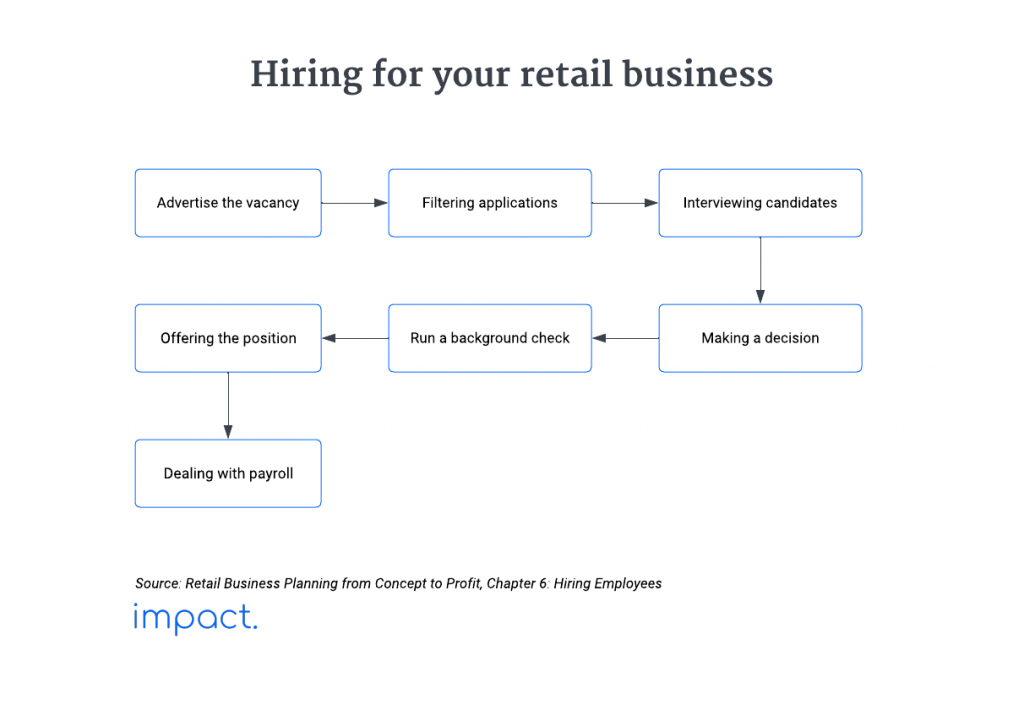
When you’re on your retail recruitment process, be crystal clear in your job ads. Spell out the role, expectations, and necessary qualifications. Make your job description appealing by highlighting the benefits of working at your retail store.
When advertising, pick the right platforms:
Traditional newspaper ads still work well, especially for local audiences. Make your ads stand out with catchy headlines to grab attention and encourage people to learn more about the job.
Remember that responses might not be immediate. Be patient and give potential candidates time to notice and respond to your newspaper ads.
Contact specialized retail recruitment agencies for fast results when hiring for your retail business. If budget is a concern, explore free state employment services.
While private employment and temp services are handy, they often charge a fee, typically around 20% of the employee’s wage or the first month’s salary. These costs may fluctuate based on the job market and required skills.
Boost your retail recruitment success by putting up a simple “Help Wanted” sign in your store or at the checkout.
Keep your current staff in the loop about the open position, explaining its impact on their roles, and encourage them to share job info when asked.
Utilize popular online job boards like Indeed, LinkedIn, or industry-specific platforms. These platforms broaden your reach beyond your local area, allowing you to tap into a wider pool of potential candidates. Craft a compelling job description to stand out among other listings.
Leverage your store’s social media accounts to announce job openings. It reaches your existing followers, who may already be familiar with and supportive of your brand. Encourage employees to share the posts, extending your reach through their networks.
Tap into your current team’s network; they might know others in the retail world who’d be a great addition. Start a referral program to motivate your team to suggest qualified candidates, fostering stronger team bonds and loyalty.
Once you’ve got a list of possible candidates, the next step is to check their applications and resumes. It helps you filter out the ones that don’t fit so you can focus on interviewing the standout candidates.
Create a shortlist of candidates whose skills and experience match the job requirements. Organize applications by prioritizing candidates with job-specific skills, relevant experience, suitable educational backgrounds, and proximity to the workplace.
Set up interviews with the candidates you’re interested in. Have a list of standard questions ready to ask about their skills, experience, and how well they fit into your business culture.
Conduct one-on-one and, if needed, group interviews to see how well candidates communicate and work in a team. Consider including practical tasks or role-playing situations related to the retail setting.
Having trouble coming up with interview questions for your retail business? Here are some examples to get you started:
After each interview, assess how sound candidates performed in interviews and assessments. Look at how well they fit into the company culture, enthusiasm, and potential for growth.
Get feedback from team members or managers in retail recruitment. Their involvement helps make informed decisions about who will be the best fit for your retail business.
According to the Society of Human Resources Management, more than half of job applications (53%) have incorrect details.
After choosing your top candidate, check their background for accurate work history, criminal records, and other essential info. Be sure to follow local laws and rules for background checks.
Get in touch with your chosen candidate and offer them the job officially. Be clear about the job responsibilities, time off policy, salary, and benefits so they can sort out any issues before they start.
Tell them their performance reviews will depend on this information and future changes. Remember to give them a deadline to say yes or no to the offer.
Once your new hire agrees to join, kick off their onboarding immediately. Get their paperwork, like tax forms and direct deposit information.
Tell them the start date, training plan, and other important information. Keep it straightforward for a smooth onboarding experience. You can simplify this process using HRIS software with onboarding and payroll capabilities.
Now that you’ve hired your team, focus on helping them grow. Good habits among retail employees are crucial, but watch out for any harmful ones.
As a retail owner, keeping your team performing and working together well is critical. Motivate them by meeting their needs, reminding them of your business’s goals, fostering honesty, and ensuring fair treatment
Basic needs like employment and money drive people. Once fulfilled, higher needs, such as belonging and self-esteem, are prioritized.
According to a Gartner survey, 82% of employees value being recognized as individuals by their employers. They seek respect from peers, coworkers, customers, and bosses, wanting to know that their contributions matter. Treat your employees respectfully, acknowledging their efforts to boost their morale and job satisfaction.
Regularly train your retail employees to refine existing skills and acquire new ones. Develop a structured training program based on job descriptions, ensuring all staff meet your store’s standards during a designated probation period.
Encourage your team to acquire extra skills that enhance their employability. Despite the risk of losing some employees to competitors, investing in skill development ensures a more profitable workforce for your business.
Get retail employee training from these sources:
In your retail business, integrity means having good character traits and work ethics like sound judgment, honesty, dependability, and loyalty.
To ensure integrity among your team, be sure to:
Unfair treatment can come from all directions — employers, customers, family, friends, or even strangers. While fairness might be subjective, it matters greatly to the person experiencing it.
Given the inherent challenges, retail business owners and managers must go the extra mile to ensure fairness for everyone involved. This commitment enhances your team and results in happy customers and greater personal satisfaction in your role as a retailer.
If someone on your team consistently falls short despite feedback and opportunities to improve, they might not be the right fit for the job, impacting your whole team and business.
In cases of ongoing performance issues, it’s common to provide warnings and reminders. But, if you’ve been given a chance, implemented a performance improvement plan, and things haven’t improved, it could be the moment to consider parting ways with that employee.
For a smooth workplace, your retail employees must share the same values as your business. If someone consistently goes against your company’s principles, it can cause problems in the team.
Before letting them go, try talking to the employee and see if training or communication can fix the issue. If it doesn’t work and their behavior keeps causing trouble, it might be best to part ways to keep an optimistic and united work environment.
In retail, keeping customers happy is vital. If an employee gets customer complaints because of lousy service or other problems, it can hurt your store’s reputation and make customers go elsewhere.
Look into why customers complain first, and try to train or guide the employee to improve. If the issues continue and it’s hurting how customers feel about your business, you might have to let that employee go to keep your store’s reputation and customer satisfaction up.
In a retail business, if someone keeps avoiding responsibility, making excuses, or blaming others, it messes up the teamwork and slows down the whole business.
To fix this, set clear rules about taking responsibility and let everyone know what happens if they don’t follow through. If someone still doesn’t step up, you might need to let them go to keep the team strong and everyone doing their best.
Consistent disruptive or unprofessional behavior, like disrespectful communication or conflicts with colleagues, can harm your team. To keep a healthy work environment, address these behavioral issues and address them promptly.
However, firing may be necessary if the bad behavior continues and affects the team. Keep records of the behavior to support your decision and avoid legal issues.
Small business owners often grapple with retail recruitment and employee retention. The process of finding the right candidate can be both time-consuming and challenging.
Consider using modern software to make retail recruitment and payroll smoother. A centralized system for managing applicants will help you review candidates faster and make better hiring choices, boosting overall efficiency.
In the next chapter, we’ll delve into intelligent store management strategies to steer your retail business in the right direction.
Ramsey, D., & Ramsey, J. (2010). The Everything Guide to starting and running a retail store: All you need to get started and succeed in your own retail adventure. Adams Media.
Impact Insight Team
Impact Insights Team is a group of professionals comprising individuals with expertise and experience in various aspects of business. Together, we are committed to providing in-depth insights and valuable understanding on a variety of business-related topics & industry trends to help companies achieve their goals.
See how our software provides better value.
Speak with our consultant to explore how we can improve your accounting, processes, and people.

As your retail business evolves with a chosen location and a well-designed interior, the next crucial move is picking your first set of products. This initial retail inventory is vital when launching a retail business, as it involves deciding on and obtaining the first batch of items your business will sell or use.
Furthermore, products will be selling fast when you open. Therefore, you should also start planning how to restock the inventory you sell right now.
Some new stores face challenges right from the start. They get caught up in setting up the store but forget to stock it with their products. On the other hand, some stores rush to buy wholesale stock, only to realize it doesn’t quite fit the store they designed.
Leverage your business plan to clarify your niche and guide your stock procurement strategy for a successful store launch. Direct your plan towards acquiring the necessary inventory to kickstart your business.

Before investing heavily in inventory, ensure a solid grasp of customer preferences gleaned from thorough market research.
Analyze the findings to align your inventory precisely with what your target audience desires, maximizing the potential success of your investment and minimizing unnecessary expenses.
If you plan to start a small or niche business focusing on personalized or handmade products, think about making the products yourself.
Pros:
Cons:
Buy products in bulk from wholesalers for cost-effective solutions and a diverse product range without the complexities of dealing directly with manufacturers. This method is ideal for retail business owners seeking efficiency and variety in their inventory.
Pros:
Cons:
Consider teaming up with manufacturers for custom products tailored to your vision, perfect for those with unique ideas or specific quality requirements in their product offerings.
Pros:
Cons:
Consider distributors as middlemen between manufacturers and retailers, simplifying the supply chain. This method works well for businesses aiming for an uncomplicated way to get products.
Pros:
Cons:
Consider dropshipping if you’re starting and don’t have much money to invest. With this model, you sell products but don’t need to keep them in stock – they’re sent directly from the supplier to the customer.
Pros:
Cons:
Explore trade shows to meet manufacturers, wholesalers, and distributors face-to-face. It’s great for businesses wanting personal connections and finding new products firsthand.
Pros:
Cons:
When picking suppliers, consider how much it costs to deliver and how fast you’ll get your stuff. Shipping can eat up to 5%-10% of your product’s cost, so be smart about smaller shipping for small orders and freight for bigger ones to keep your profits in check.
Meanwhile, slow wholesale orders and sluggish shipping mean getting your products could take weeks or months. If you have a specific opening date, choose suppliers who can deliver your inventory quickly to avoid delays.
In the current retail landscape, pricing is intricate, and competition limits the flexibility to set prices arbitrarily based on market demand.
When determining a retail price, consider these methods:
The break even point is the level of sales at which total revenue equals total costs, resulting in neither profit nor loss. Determining the break-even point is crucial for setting a baseline sales target that covers all costs.

Calculate fixed costs (e.g., rent, utilities), variable costs (e.g., cost of goods sold), and selling price. Reaching the break even point occurs when selling a certain quantity generates total revenue covering fixed and variable costs.
Cost-plus pricing involves calculating the total cost of producing or purchasing a product and then adding a markup percentage to determine the selling price. This pricing method ensures that each unit sold covers variable and fixed costs and generates a profit.

Determine the cost of producing or purchasing each unit, and then add a percentage markup to cover both costs and generate profit. The challenge is accurately assessing costs and choosing an appropriate markup percentage based on industry standards and competitive pricing.
Rate-of-return pricing, or target-return pricing, involves setting prices to achieve a target rate of return on investment. This method focuses more on profitability and aims to generate a specified percentage return on the capital invested in the business.

Determine the desired rate of return on the investment in the business. Calculate the cost per unit and add a portion of the rate of return to the selling price. This method requires a clear understanding of the desired return and the total investment made in the business.
Demand pricing involves setting the price based on the product’s perceived value in the market. Prices are determined by what customers are willing to pay, considering factors like brand image, exclusivity, and market demand.
This method relies on understanding customer behavior and market dynamics to set a price that maximizes revenue by balancing the product’s perceived value with consumer willingness to pay.
Plan to restock your inventory to avoid empty shelves and customer dissatisfaction.
To do this, keep track of your retail sales and prioritize restocking the best-selling and most profitable items. Utilize an efficient inventory management system to gain the necessary insights for effective restocking.
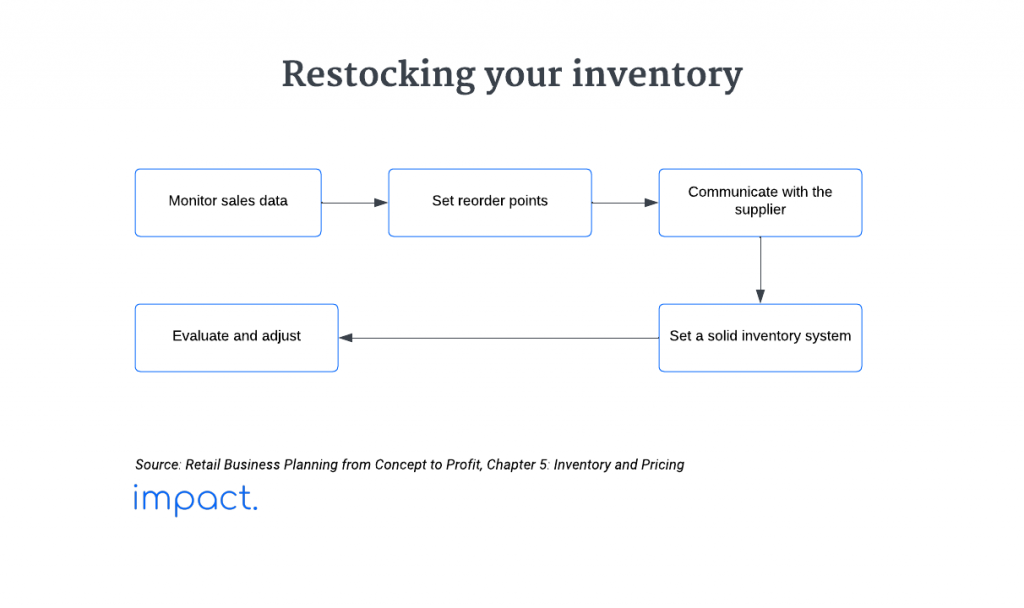
Regularly check your sales data to identify trends in customer purchases and timing. Use historical sales information to determine seasonal popularity and evolving customer preferences.
By checking your retail sales data, you’ll understand what your customers want and when they want it. It helps you stock up on the right products at the correct times so you’re ready to meet demand and keep customers happy.
Determine optimal product reorder points by analyzing sales history and delivery times. Include extra stock to handle unexpected demand or delays, ensuring you maintain a reliable and responsive inventory.
Setting the right reorder points means always having products available when customers want them. It helps you avoid running out of stock or having too much inventory, keeping your business running smoothly.
Maintain regular communication with suppliers from the sourcing of your initial inventory. Keep them informed about your retail sales and stock needs to facilitate efficient production planning.
Good communication with your suppliers ensures you know if there are any issues with getting the needed products. By keeping them in the loop about your sales, they can better plan their production schedules to meet your demands.
Automate your restocking process by leveraging technology to track retail sales and automatically reorder items when running low. It saves time and minimizes the risk of errors in the restocking procedure.
Automation makes your life easier, it helps you stay on top of your inventory without manually tracking every sale. This way, you can focus on growing your business instead of worrying about running out of stock.
Regularly review your restocking strategy and make changes based on market shifts, customer behavior, or any factors affecting your business for sustained effectiveness.
By reviewing and adjusting your strategy, you make sure your restocking process stays effective. It keeps your inventory management sharp and your business competitive.
For small retail businesses, keeping track of inventory can be straightforward with essential lists, or you can take it further by connecting with your suppliers. While a manual system might work, consider investing in inventory management software — it’s a smart move for boosting efficiency and accuracy in your operations.
Setting the correct prices for your products is crucial for retail success. It’s more than doubling the wholesale cost; you must explore various strategies to maximize your profits. In the next section, we’ll delve into the essentials of hiring and training your team as you build your retail business.
Ramsey, D., & Ramsey, J. (2010). The Everything Guide to starting and running a retail store: All you need to get started and succeed in your own retail adventure. Adams Media.
Impact Insight Team
Impact Insights Team is a group of professionals comprising individuals with expertise and experience in various aspects of business. Together, we are committed to providing in-depth insights and valuable understanding on a variety of business-related topics & industry trends to help companies achieve their goals.
See how our software provides better value.
Speak with our consultant to explore how we can improve your accounting, processes, and people.

In the last chapter, we covered why your retail location matters. Now that you’ve chosen your store’s location let’s dive into practical tips for designing and furnishing your store’s interior.
A retail layout is how you strategically use retail space to shape your customer’s experience. It involves critical elements like where you place displays and fixtures, organize zones and departments, and position merchandise.
A good retail layout helps customers move around with ease. Clear paths and organized sections make shopping more enjoyable, preventing frustration and boosting satisfaction.
Putting popular or high-profit items in strategic spots guides customers to different sections, prompting them to explore and find more things they might like.
A well-planned retail layout helps retailers use their space wisely by positioning products strategically. Neat shelves and displays prevent mess and make the store more welcoming, maximizing floor space for a more comprehensive product selection and a comfortable customer experience.
Moreover, an organized layout improves store operations. Employees can move around efficiently, restock shelves easily, and assist customers more effectively.
According to POPAI (Point of Purchase Advertising International), where you put things in your store can impact sales — 76% of in-store decisions are influenced by displays and placement.
Creating a nice-looking store with well-thought-out product displays boosts your customers’ mood and increases their chances of buying something. Place products strategically and make eye-catching displays to shape how customers see your items, nudging them toward purchasing.

Define what you’re selling and how you want customers to feel when they shop with you. Figure out how many items you’re stocking and how to show it off best. Also, consider where to keep your extra stock, set up cash registers, and create workspaces for your team.
The store design can help customers solve their pain points. When a customer enters a store, their decision process goes through need, choice, and commitment.
Organize your store layout with the customer in mind to boost sales and keep customers returning. Strategically position products, design eye-catching displays, and enhance the overall shopping experience to smoothly guide customers from browsing to buying, increasing the chances of making a sale and building loyal customers.
Retail stores have different layout types, each with advantages and disadvantages. So consider wisely according to the store you set up and the products you sell.
Grid layout arranges aisles and merchandise in a grid pattern. Products are shown in a predictable pattern that’s easy to navigate.
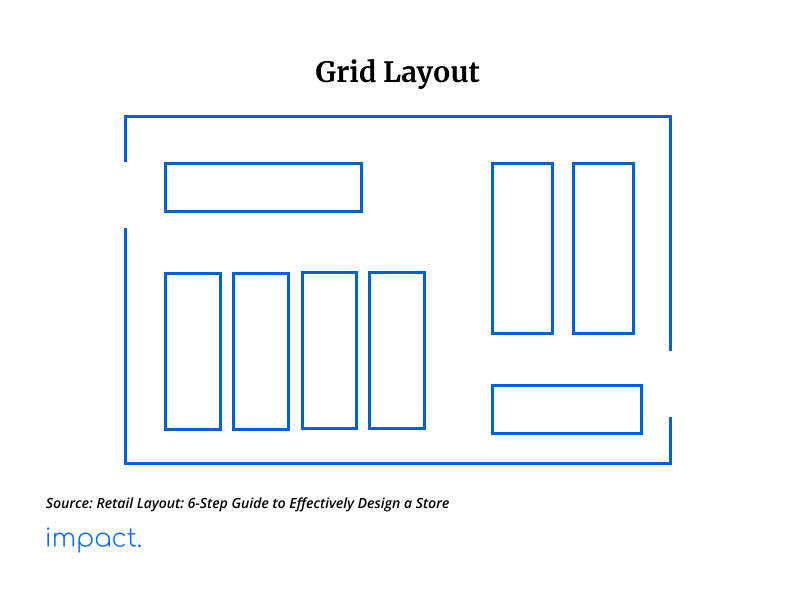
Typically found in grocery and convenience stores, the grid layout features long aisles with staple items at the back and impulse-purchase items near the checkout.
Pros:
Cons:
This retail layout has a central aisle that makes a loop, like a racetrack, leading customers in a steady flow past the merchandise.

This store design creates a closed loop that leads shoppers past all the merchandise in the store. The layout is standard in larger retail spaces, such as department stores and clothing outlets.
Pros:
Cons:
This layout lacks a specific structure, allowing for more flexibility and creativity in placing aisles and displays.
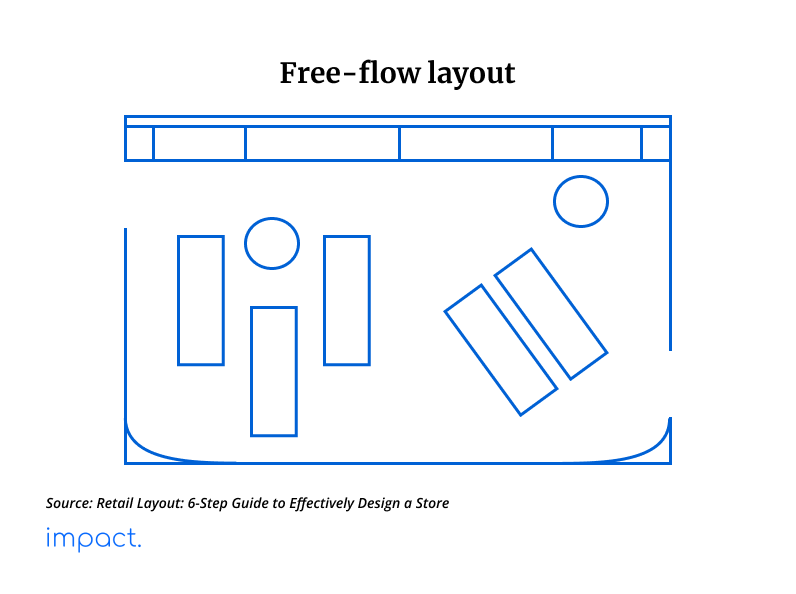
It encourages shoppers to wander around the store and explore the products at their own pace without a prescribed pattern. This layout suits small spaces and is best suited for high-end stores with less merchandise but an emphasis on experiential retail.
Pros:
Cons:
Also known as the spine layout, this design arranges fixtures and merchandise in straight lines to establish clear sightlines and organized pathways.
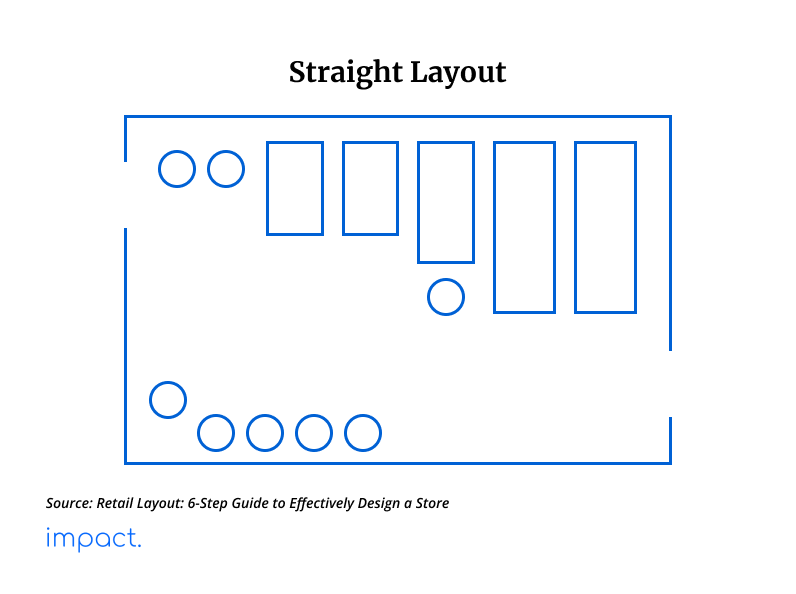
It engages shoppers with signage, product displays, and strategic merchandise placement. When executed correctly, this straightforward method can establish an inviting space that encourages shoppers to spend more time browsing.
Pros:
Cons:
The diagonal layout arranges aisles and displays at angles other than 90 degrees, creating a dynamic and visually exciting store design.
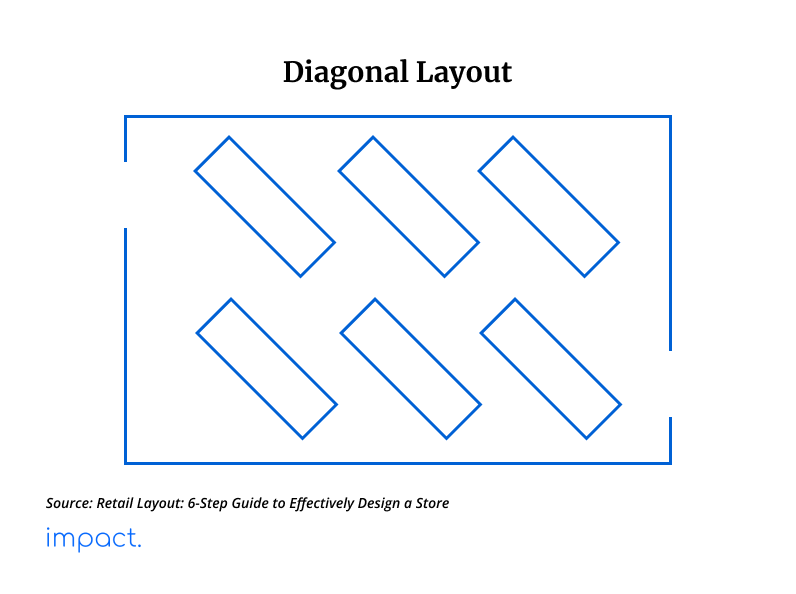
Ideal for stores with limited retail space, this layout promotes movement, ensuring customers can easily view all products. It is commonly used in apparel stores, boutiques, and larger retail spaces.
Pros:
Cons:
In a retail store, focus on four key zones: the entry, cash wrap (checkout area), the sales floor, and the back room. Here are the design guidelines for each area.
This space aims to create a welcoming first impression and draw customers inside. It encompasses the window display and a transition area — an open and appealing space near the door where new customers can quickly pause and survey the surroundings.
Design guidelines:
The cash wrap or checkout area is designed for quick and easy transactions to create a positive, lasting impression. The best location for it is near the main entrance and alongside the area where you transition to the sales floor.
Design guidelines:
The sales floor is where you show off your products in a way that makes sense and is easy for customers to get to. Ensure your products are easy to see and encourage people to look around.
Not only should the sales floor help customers decide what to buy, but it should also suggest other things they might want. Customers might remember something else they need and buy more stuff.
Design guidelines:
The back room is a practical area for managing inventory and staff tasks. It’s also a place where employees can take breaks and relax.
If you have many products that can’t fit on the sales floor, store them in the back room. Set up a shipping area with a table and supplies if you need to send items to customers or return them to suppliers.
Design guidelines:
Like in your home, retail stores have different types of furniture and fixtures. What fixtures your store needs depends on what you’re selling.
Primary fixtures are a store’s main, permanent structures that shape its layout and overall design. They’re like the backbone, supporting the store’s look and providing the main structure for displaying stuff.
You can usually get them from fixture makers, retail design companies, or construction suppliers. Here’s a list of examples typically used in retail stores:
Secondary fixtures add flexibility and visual interest to your store layout. They’re versatile and easy to move around, making changing displays for different products or promotions simple.
You can find these fixtures from suppliers like fixture manufacturers, display equipment vendors, and online retailers focusing on retail. Examples of secondary fixtures include:
Check your store’s layout plan and make changes if necessary. Make sure the layout follows safety rules and accessibility standards.
Test the flow of the layout design by simulating customer journeys. If there are still issues, adjust the layout based on what you observe.
Your store layout is crucial for how customers see your brand. It impacts foot traffic, customer experience, and what they choose to purchase.
When designing your store layout, always consider your customers — aim for a quick and convenient shopping experience. Use software with Point of Sale (POS) capabilities to ensure smooth operations.
In the next chapter, we’ll help you pick and fill up your retail business with the proper inventory, set its retail price, and plan for restocking.
Ramsey, D., & Ramsey, J. (2010). The Everything Guide to starting and running a retail store: All you need to get started and succeed in your own retail adventure. Adams Media.
Impact Insight Team
Impact Insights Team is a group of professionals comprising individuals with expertise and experience in various aspects of business. Together, we are committed to providing in-depth insights and valuable understanding on a variety of business-related topics & industry trends to help companies achieve their goals.
See how our software provides better value.
Speak with our consultant to explore how we can improve your accounting, processes, and people.

Previously, we highlighted that a significant reason businesses fail is due to a poor retail location. A lousy location means customers can’t find your store, resulting in lower profits from fewer sales.
This chapter will help you choose the best retail location for your business. It covers the criteria to think about, various types of locations, and how to negotiate your lease.
For your retail store to thrive, focus on being easily seen and reachable. Choose a spot where many people pass by so your store catches their attention, and they’re more likely to check it out.
Plus, make sure it’s easy for customers to get there, whether they’re walking, driving, or using public transportation, so they find it convenient to visit often.
Select a location that matches the characteristics and preferences of your target customers, making it easy and convenient for them to reach your store.
If your target audience is young professionals, consider setting up shop in a business district or close to office spaces. For a store serving families, opt for a location near residential areas or schools, ensuring your offerings align with the daily requirements of your desired customer base.
Consider your business size when deciding how close to set up shop to competitors. Smaller businesses may encounter more challenges, while larger ones could discover growth opportunities nearby.
A study from the Marriott School of Business suggests that deciding on your store’s location concerning competitors needs careful thought. The survival rate for the smallest businesses drops by 14.1 percentage points, but it goes up by 2.6 percentage points for the largest ones.
Controlling expenses and maximizing profits are crucial to running a successful retail business. Keep your store’s lease and rent manageable by balancing costs and potential revenue for long-term sustainability.
A higher-rent location justifies itself by generating significantly more foot traffic, increasing sales. Conversely, a cheaper location may be practical if it provides sufficient visibility and accessibility to your target audience.
A mall is a vast shopping area where customers can conveniently find various stores under one roof, ranging from big-box retailers to independent shops.
This location suits businesses that do well in a competitive retail environment and want to reach a wide range of customers, like clothing stores and electronic shops.
Pros:
Cons:
Stand-alone stores are unique establishments that operate independently, not relying on other retailers or malls to attract customers. They serve as their destination, focusing on specific market segments such as food, health, beauty products, or electronics.
Pros:
Cons:
“Ruko” is a term derived from “Rumah Toko,” meaning a place that combines living space and business operations. Usually spanning two or three floors, a ruko is valued for its practical layout, enabling owners to reside and run their businesses conveniently.
Ideal for small retail ventures, local shops, or boutique stores, Ruko is perfect for owners who desire hands-on involvement in daily operations and the convenience of living at the exact location.
Pros:
Cons:
Consider setting up your retail store at home, especially when just starting. It’s a practical choice, especially if you’re unsure about other locations.
Pros:
Cons:
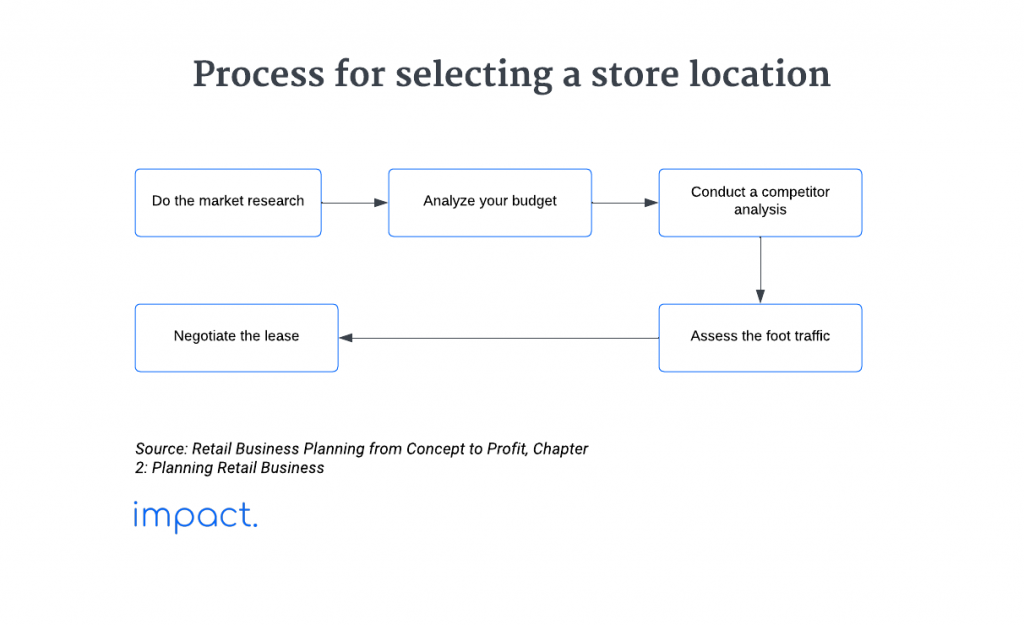
To succeed in retail, you should emulate larger companies by understanding their customers’ buying habits, preferences, and demographics. Begin by conducting demographic research on potential customers to determine the right location for your business.
Understanding demographics provides basic information, while psychographics delve into opinions, attitudes, and buying behaviors. Although psychographic research may cost more due to in-depth interviews, it uncovers valuable insights that can boost your effectiveness in serving customers and give you a competitive advantage in the retail business.
Ensure your business plan covers startup and operating costs, funding sources, sales projections, and cash flow details. Look closely at the financial analysis to determine a reasonable rent and related expenses budget.
Be practical about location choices, considering your budget constraints, and explore affordable options, such as up-and-coming neighborhoods, to avoid straining your resources.
Identify existing businesses in the area you’re considering and analyze their strengths and weaknesses. Assess whether there is room for your retail business to thrive alongside competitors.
Also, look out for nearby businesses that would complement you. For example, if you’re opening a bookstore, being close to a coffee shop could make shopping more enjoyable for customers.
Choose locations by watching how many people pass by. A bustling street may bring in more customers, but it usually means higher rent.
Think about when foot traffic is busiest during the day and week. Being close to offices with many lunchtime visitors could be smart if your shop sells snacks.
After finding the right spot, talk to the landlord about terms, rent, and any extra expenses — research local rates to make fair comparisons.
As a new retailer with a small business, know that you have negotiating power for your retail lease. Negotiate confidently for terms that fit your budget and business goals. Don’t hesitate to ask for favorable conditions.
In a fixed-rent lease, you pay a set monthly amount, no matter how much you sell. The size of your store usually determines this payment.
A fixed-rent lease can be a good fit if your retail business has a steady and predictable income. It helps you plan your monthly budget by keeping your expenses.
Pros:
to sales.
Cons:
In this unique setup, retail tenants pay rent based on a percentage of their total sales over a specific time, often quarterly, though some prefer monthly or yearly.
This kind of retail lease works well for retail ventures with sales that vary, connecting rent directly to how well the business is doing. It’s a way for landlords and tenants to team up in facing the ups and downs of the business together.
Pros:
Cons:
In a percentage-with-minimum lease, you pay rent based on a percentage of your sales, but you must pay a minimum amount even if your sales go down.
This type of retail lease can be a good choice if you’re running a growing retail business. It gives you a fixed cost and the flexibility to pay less when sales are slow or more when they’re booming.
Pros:
Cons:
Negotiating a retail lease differs depending on your market, the property, and the landlord. It’s essential to do thorough research because each situation has its quirks.
Collect detailed info on market conditions, property details, landlord reputation, and similar deals. To make informed decisions, compare your current lease terms and costs with industry standards.
When negotiating your retail lease for a retail space, remember it’s not just about numbers and paperwork; it’s about building solid relationships. Foster trust with your landlord through clear, respectful communication, and keep a positive and professional tone throughout the negotiation.
Ensure a solid lease negotiation by getting everything in writing. Verbal agreements don’t count in real estate — only a signed agreement with the terms you’ve discussed matters.
Double-check and clarify every detail by carefully documenting all lease terms. Review the written agreement thoroughly, addressing gaps, errors, or uncertainties to avoid future issues.
Review your lease to understand when the landlord can terminate it. Check if not paying rent or selling the property allows them to evict you.
Find out how you can end the retail lease if you want to grow your business. If you’re closing the business, consider subletting your store to another tenant.
Navigating real estate law can be tricky, especially with the legal jargon and complex clauses found in lease agreements. To steer through this, consider consulting with a real estate lawyer who can break down the complexities and make them easier to grasp.
A specialized lawyer can offer a straightforward explanation of your rights and responsibilities in the retail lease. It ensures that you fully understand the terms you agree to, preventing potential disadvantages.
To find the right spot for your retail business, thoroughly research potential locations, analyze your budget, and understand your target customers well. Making informed decisions at this stage is crucial for the success of your retail venture.
Choosing the right retail location isn’t just about securing a space; it’s a strategic advantage that can boost your business. In the next chapter, we’ll guide you through setting up your store, covering critical elements like layout planning and furnishings.
Ramsey, D., & Ramsey, J. (2010). The Everything Guide to starting and running a retail store: All you need to get started and succeed in your own retail adventure. Adams Media.
Impact Insight Team
Impact Insights Team is a group of professionals comprising individuals with expertise and experience in various aspects of business. Together, we are committed to providing in-depth insights and valuable understanding on a variety of business-related topics & industry trends to help companies achieve their goals.
See how our software provides better value.
Speak with our consultant to explore how we can improve your accounting, processes, and people.
